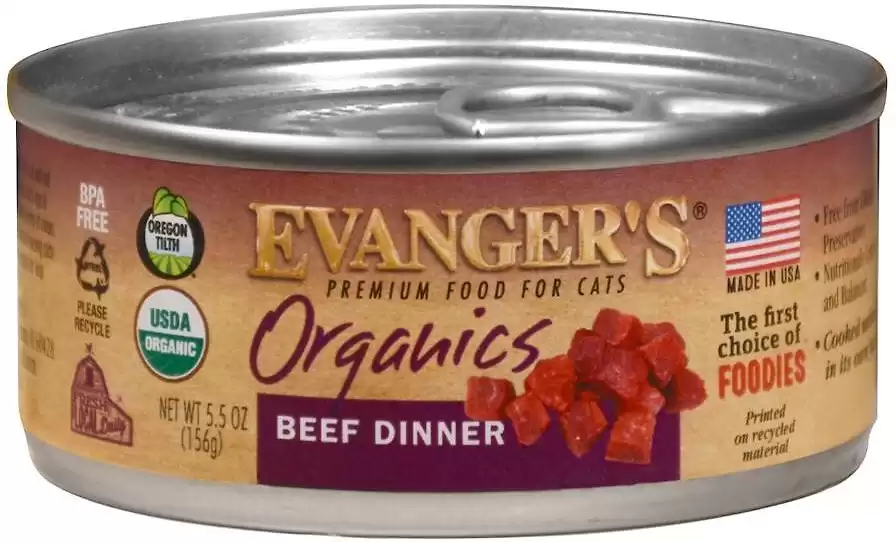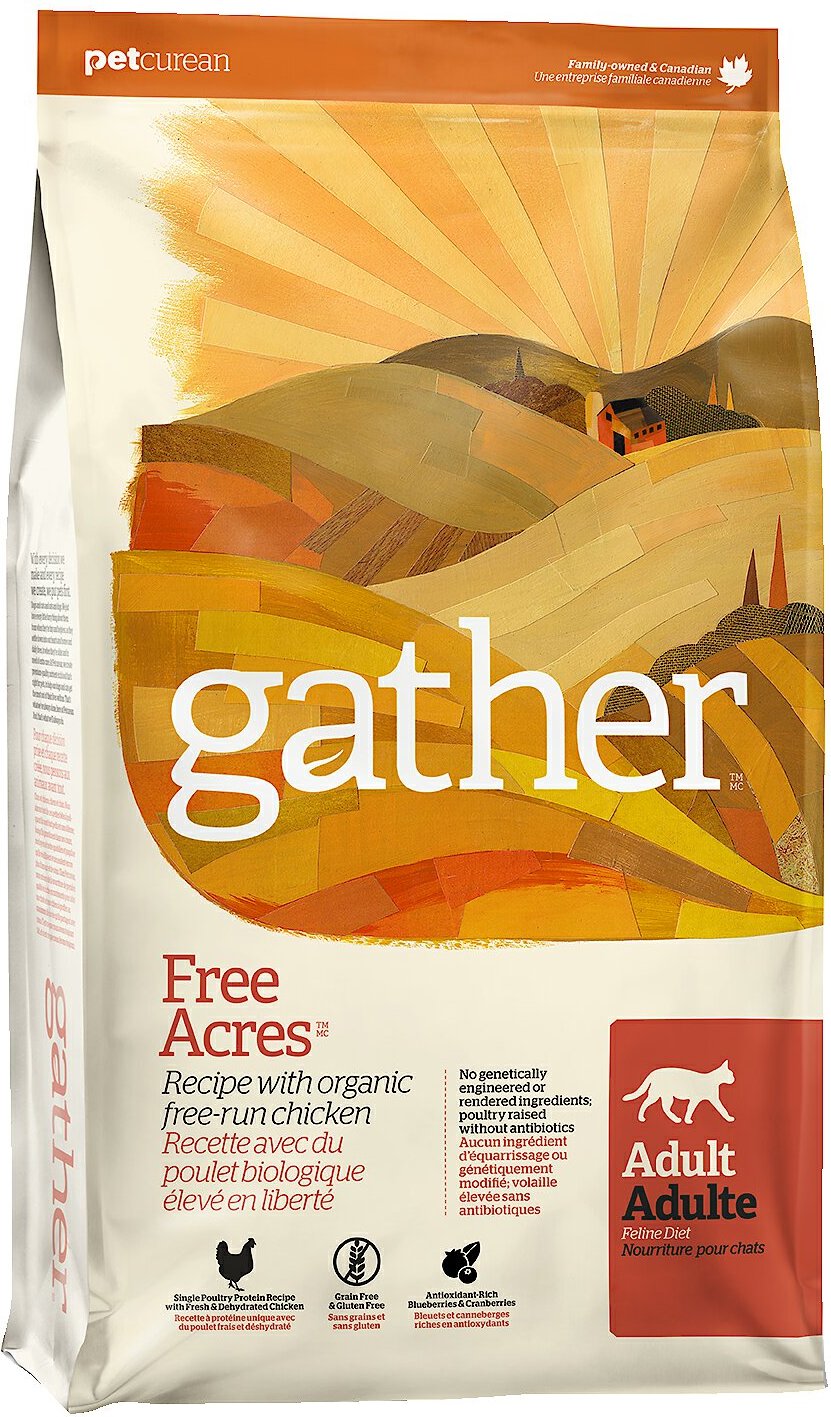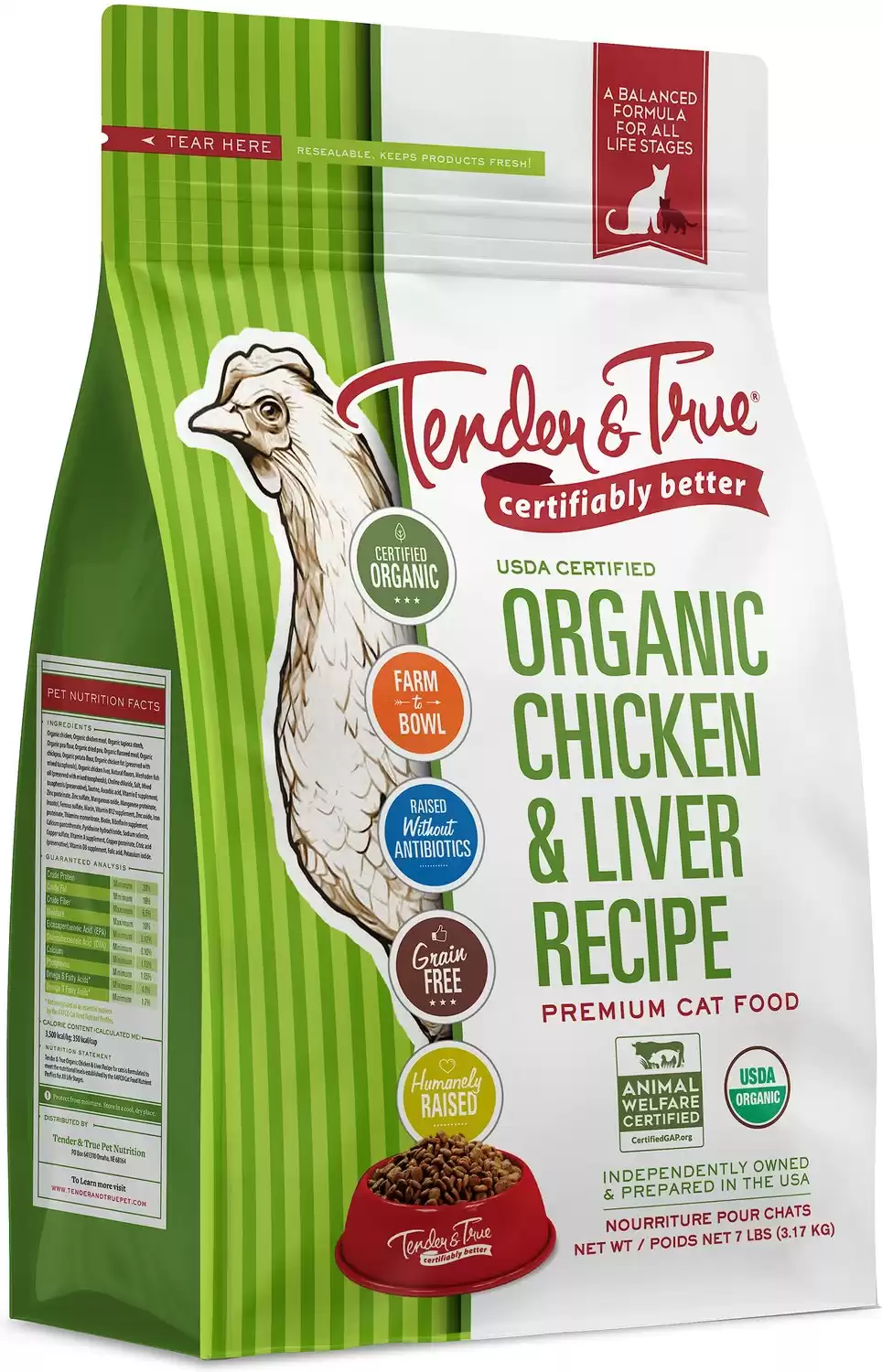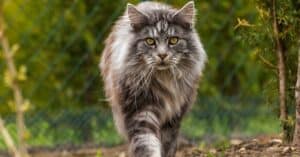| Best for | Product |
|---|---|
| Best Overall | Evanger’s Organics Grain-Free Canned Cat Food |
| Best Kibble | Gather Free Acres Organic Free-Run Chicken Dry Cat Food |
| Best for Kittens | Whole Earth Farms Grain Free Wet Kitten Food |
| Best on a Budget | Tender & True Organic Grain-Free Dry Cat Food |
As a pet parent, it’s your job to provide them with a diet that is full of nutrients. If you’ve owned a cat for a while, you’ll know that they can be quite the picky eaters. Just like toddlers (and most adults, let’s be honest), cats would rather eat what tastes good versus what’s healthiest for them.
Because felines are carnivores, their diet requires fat, protein, minerals, and plenty of vitamins. Cheap kibble on the market is commonly filled with unhealthy fillers. Is there organic food available that will please your picky kitty?
We’ve scoured the web and pet store chains to find the highest quality, tastiest, and overall best organic cat food for your furry friend. It can be tough knowing how to choose which will work for your feline, so we’ve included a handy buyer’s guide to help you along the way.
 Check Chewy
Check Chewy- Made from organic beef
- Also includes organic liver and beef kidney
- Includes at least 95% organic ingredients
- USDA-organic certified
- Free from hormones, grains, GMOs, and antibiotics
 Check Chewy
Check Chewy- Contains organic free-run chicken as the first ingredient.
- Includes non-GBO vegetables such as peas and lentils.
- It is free from antibiotics and growth hormones.
 Check Amazon
Check Amazon- Provides balanced nutrients for your kitten's growth and development
- The first ingredient is deboned chicken
- Also includes chicken liver and eggs
- Free from fillers like wheat and soy
- Can be fed to adult cats that need to gain weight with your veterinarian's direction
 Check Chewy
Check Chewy- The first ingredient is USDA-certified organic chicken
- The chicken is also certified to be humanely raised
- 100% complete nutrition
- Includes added vitamins, minerals, and trace nutrients
- Free from grain, GMOs, corn, soy, wheat, and artificial colors, flavors, and preservatives
A-Z Animals Top Picks for the Best Natural (Organic) Cat Food
#1 Overall Best: Evanger’s Organics Grain-Free Canned Cat Food
In our opinion, the best overall organic cat food is Evanger’s Organics Grain-Free Canned Cat Food.
Tis tasty soft food uses organic beef to provide a flavor your cat will love. It’s made with organic liver and organic beef kidney as well.
As it’s made with at least 95% organic ingredients, this food has earned the USDA-organic certification. All the ingredients are cooked in their own juices and are free of hormones, grains, GMOs, and antibiotics!
This mixture is also intended to assist in healthy digestion, skin and coat health, weight management, and hairball relief in cats. It’s designed with adult cats in mind and should be given only to felines that are at least 12 weeks old. However, some owners have reported that their pets do not like this food.
Pros and Cons of Evanger’s Organics Grain-Free Canned Cat Food
| Pros | Cons |
|---|---|
| This food contains organic beef, liver, and beef kidney. | Not all cats like this food. |
| It is USDA certified with 95% organic ingredients. | It is not suitable for cats less than 12 weeks old. |
| It is free from hormones, grains, GMOs, and antibiotics. | |
| It promotes a healthy weight, coat, and digestive system. |
- Made from organic beef
- Also includes organic liver and beef kidney
- Includes at least 95% organic ingredients
- USDA-organic certified
- Free from hormones, grains, GMOs, and antibiotics
2. Best Kibble: Gather Free Acres Organic Free-Run Chicken Dry Cat Food
As the best kibble we recommend the Gather Free Acres Organic Free-Run Chicken Dry Cat Food.
This USDA-certified organic food contains organic free-run chicken as the main ingredient. It also contains tasty non-GMO veggies such as peas and lentils. Plus, it is enhanced with vitamins and minerals to promote all-round good health. It also contains taurine which is essential for healthy vision and heart health. Not only that, but this food is free from antibiotics, growth hormones, corn, wheat, soy, gluten, and artificial colors, flavors, and preservatives.
Again, the only issue with this food is that not all cats like it.
Pros and Cons of the Gather Free Acres Organic Free-Run Chicken Dry Cat Food
| Pros | Cons |
|---|---|
| This food contains organic free-run chicken as the main ingredient. | Not all cats like this food. |
| It is USDA-certified organic. | |
| It includes non-GMO vegetables. | |
| This food is free from antibiotics, growth hormones, corn, wheat, soy, gluten, and artificial colors, flavors, and preservatives. |
- Contains organic free-run chicken as the first ingredient.
- Includes non-GBO vegetables such as peas and lentils.
- It is free from antibiotics and growth hormones.
3. Best for Kittens: Whole Earth Farms Grain Free Wet Kitten Food
Next, we have an option for all of those adorable kittens out there! The Whole Earth Farms Grain Free Wet Kitten Food provides a balanced diet for your kitten’s growth and development.
The first component in this food is deboned chicken, followed by healthy ingredients obtained in the United States, such as chicken liver and eggs. It also includes a variety of nutrients to enhance health and vigor, including essential vitamins and minerals for developing kittens. Also, grain, maize, wheat, soy, and peas, which are commonly utilized as fillers in cheap foods, are absent from the diet.
Unfortunately, some customers reported that they received damaged and dented cans.
Pros and Cons of the Whole Earth Farms Grain Free Wet Kitten Food
| Pros | Cons |
|---|---|
| The main ingredient in this food is deboned chicken. | Some custoemrs received dented cans. |
| It contains vitamins and minerals that are essential for the healthy development and growth of kittens. | |
| It is free from grain, maize, wheat, soy, and peas. |
- Provides balanced nutrients for your kitten's growth and development
- The first ingredient is deboned chicken
- Also includes chicken liver and eggs
- Free from fillers like wheat and soy
- Can be fed to adult cats that need to gain weight with your veterinarian's direction
4. Best on a Budget: Tender & True Organic Grain-Free Dry Cat Food
Quite often, organic cat food can be expensive, but with this option you don’t need to worry about it putting a dent in your wallet. Therefore, the best budget option is the Tender & True Organic Grain-Free Dry Cat Food.
While soft food is more evolutionary similar to a cat’s normal diet, dry food offers a lot of advantages. Kibble is more accessible, less expensive, and can be left out for longer periods of time than canned food.
However, the vitamin and calorie content of the food is more essential than the method in which it is consumed. This food is made with 95% USDA Certified Organic chicken and turkey, as well as chicken liver. Its ingredients are straightforward, and it’s made in the United States.
The Global Animal Partnership (GAP) certifies organic farm-produced chicken and turkey, indicating that the animals were treated humanely. This meal also contains vitamins, minerals, and omega-3 and omega-6 fatty acids and is made up of 30% crude protein and 18% fat.
Each dish is free from hormones and antibiotics, as well as artificial colors, flavors, and preservatives. This food is AFFCO Certified for all life stages and comes in three-pound and seven-pound packages. However, the kibble pieces are quite small which may not suit all cats.
Pros and Cons of the Tender & True Organic Grain-Free Dry Cat Food
| Pros | Cons |
|---|---|
| This food is certified as 95% USDA organic. | The kibble pieces are small which may not suit all cats. |
| It contains chicken and turkey as the main ingredients. | |
| It contains vitamins, minerals, and omega-3 and omega-6 fatty acids. | |
| It is free from hormones and antibiotics. | |
| It is AFFCO certified for all life stages. |
- The first ingredient is USDA-certified organic chicken
- The chicken is also certified to be humanely raised
- 100% complete nutrition
- Includes added vitamins, minerals, and trace nutrients
- Free from grain, GMOs, corn, soy, wheat, and artificial colors, flavors, and preservatives
Choosing the Best: What to Look For
Now that you know which of the organic foods makes the cut, how do you know what you should be looking for? Below you’ll find some of the most important features in organic cat food that can help you distinguish what’s worth your hard-earned money.
Organic Certification
The use of the phrase “organic” in terms of human and pet food is regulated by the United States Department of Agriculture (USDA). The law requires the USDA to apply the same standards to cat food as they do to human food. The term “organic” describes how a product or animal is cultivated, reared, and managed.
Organic crops must grow for at least three years on pesticide-free land. Harmful chemical pesticides, artificial flavors, dyes, additives, synthetic growth hormones, pharmaceuticals, Genetically Modified Organisms (GMOs), and irradiation must all be avoided in the food.
Organic cattle used in pet meals must consume organic feed, be free of antibiotics and hormones, and have access to nature. The USDA inspection must record and validate all of these standards in order to become USDA Certified.
It’s impossible to know if a product is genuinely organic unless it says “USDA Certified Organic” on the label. You’ll notice a number on the label if only a percentage of the components are certified organic, such as “97% USDA Certified Organic.”
Other Labels
Likewise, for cat food and animal feed, the Association of American Feed Control Officials (AAFCO) defines and regulates the phrase “natural.” “Natural” refers to a feed or component that is made entirely from plant, animal, or mineral sources rather than a chemically synthesized approach.
Some components, however, might be branded “natural” without being beneficial or healthful for your pet. Keep an eye out for “fillers,” which are low-cost but have little nutritious benefit. They’re included to help your pet feel full while consuming fewer high-quality components.
Corn and wheat gluten, grains and beans, soy, animal by-products, and fruit and vegetable pulps are all common examples. For felines with allergies, hair issues, or digestive concerns, stick to “grain-free” foods.
Nutrition
It’s also crucial to consider your cat’s food’s nutrients, moisture, and fat level. Cats emerged as hunters, therefore their natural diet would consist mostly of carnivorous animals. They would eat prey with a high protein content, a moderate fat content, and a small amount of carbs.
So keep an eye out for foods that are high in carbohydrates and may contribute to obesity. Look for foods that have carbohydrates from organic squash, sweet potato, or brown rice. Minerals, vitamins, fatty acids, and amino acids are among the additional nutrients cats need.
From kitten to teenager, during pregnancy and breastfeeding, and as a geriatric cat, the quantity of nutrients required varies. Supplements aren’t necessary if your cat’s food is has everything your furry friend needs and appropriate for his or her present stage of life.
Raw Food
This takes us to the topic of raw foods. Raw food is a new trend in pet food that is considered to be the best option since heat does not break down proteins and other critical elements. Raw meals, on the other hand, raise the danger of salmonella and listeria bacterial infections, which can cause diarrhea, vomiting, and finally a nervous system illness.
To avoid rotting and enhance shelf life, producers utilize natural preservatives in-store products. Vitamin C (ascorbic acid) and vitamin E are examples of non-synthetic preservatives.
Macro Nutrients
Ingredients are given in order of weight, from most to least, and contain proportions of protein, fat, fiber, and moisture, much like in human food ingredient labels. Look for foods with a high protein content of certain meat first, and if there are any grains, whole grains are ideal because of the benefits they carry.
Soft vs. Wet Food
Because soft food ratios are reported on a wet basis and contain a high amount of moisture, dry food percentages are reported on a dry basis. Protein and fat content figures will be greater in dry foods than in wet foods.
Soft foods should have a protein content of at least 8% to 10%. Dry food should have at least 25%. Wet food should have a minimum fat level of 5%, whereas dry food should have a fat content of 20% to 30%. Some kitties will reject foods that are lower in protein or fat than is advised. The average cat thrives when fed both wet and dry food on a weekly basis.
Probiotics
Many products include probiotics, which help to maintain a healthy gut flora. This decreases inflammation, boosts the immune system, and may have other advantages. Because house cats don’t consume a natural diet of rodents and other creatures, their stomachs aren’t subject to the germs they’d find in the wild. When in doubt, use probiotics, particularly if your cat has a sensitive stomach or has just had antibiotics or other drugs.
The Different Types of Organic Cat Food: Pros and Cons Compared
Though there aren’t necessarily different types of wet cat food, we still wanted to let you in on some of the advantages and disadvantages of feeding your cat the various types of organic food. Let’s take a look at the important information below.
Dry Cat Food
| Pros | Cons |
|---|---|
| It comes in bigger packages. | It can mold if not used fast enough, |
| It tends to be cheaper. | |
| There are more options on the market. | |
| It helps with dental health by removing plaque and tartar. |
Wet Cat Food
| Pros | Cons |
|---|---|
| It has a higher water content. | It is more expensive. |
| It is more palatable and appetizing for picky eaters. | It can go off it not refridgerated once opened. |
| You can hide medication in it. | It does not help with dental health. |
| It is easier for cats with dental issues to eat. |
| Best for | Product |
|---|---|
| Best Overall | Evanger’s Organics Grain-Free Canned Cat Food |
| Best Kibble | Gather Free Acres Organic Free-Run Chicken Dry Cat Food |
| Best for Kittens | Whole Earth Farms Grain Free Wet Kitten Food |
| Best on a Budget | Tender & True Organic Grain-Free Dry Cat Food |
The Top Natural (Organic) Cat Food: Reviewed FAQs (Frequently Asked Questions)
Can cats consume organic food?
It has been scientifically proven that organic cat food has far fewer pesticides than non-organic cat food, so if you are concerned about the impact of these chemicals on your cat, try switching to organic cat food.
Is it safe for cats to eat organic chicken?
Chicken is safe for cats to consume. Many high-quality cat meals contain chicken. However, there are a few things to keep in mind before introducing this delightful delicacy to your cat’s diet, such as real chicken vs. chicken meal.
Thank you for reading! Have some feedback for us? Contact the AZ Animals editorial team.




